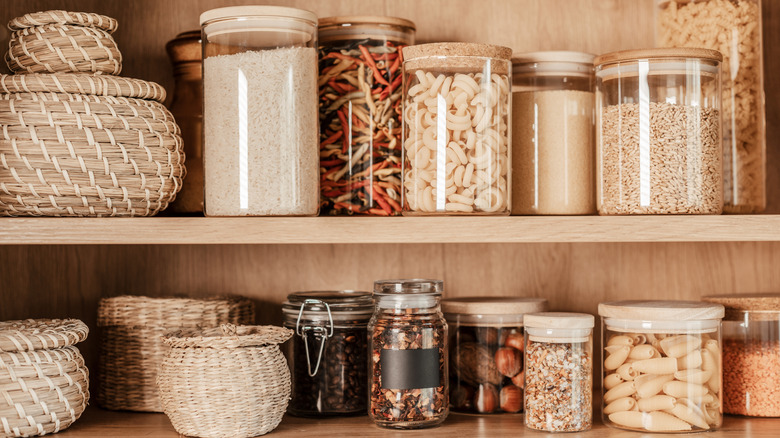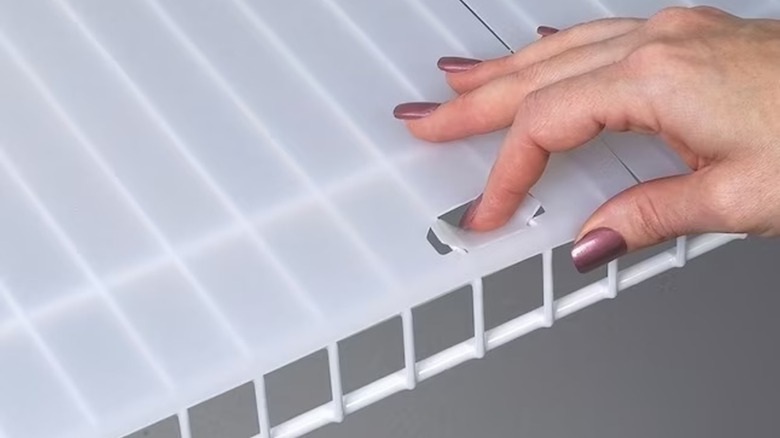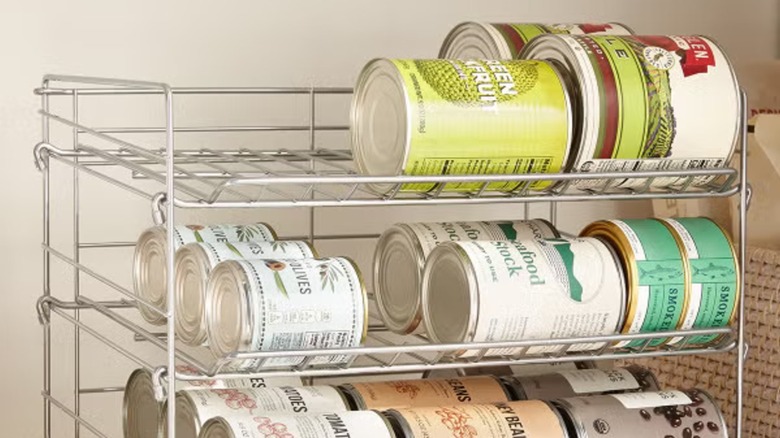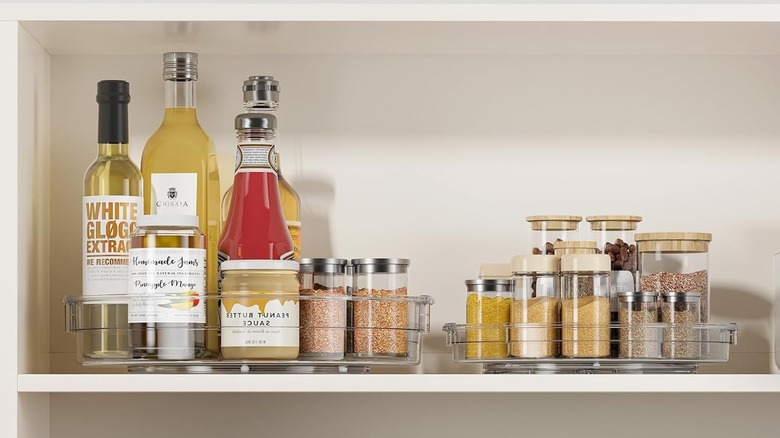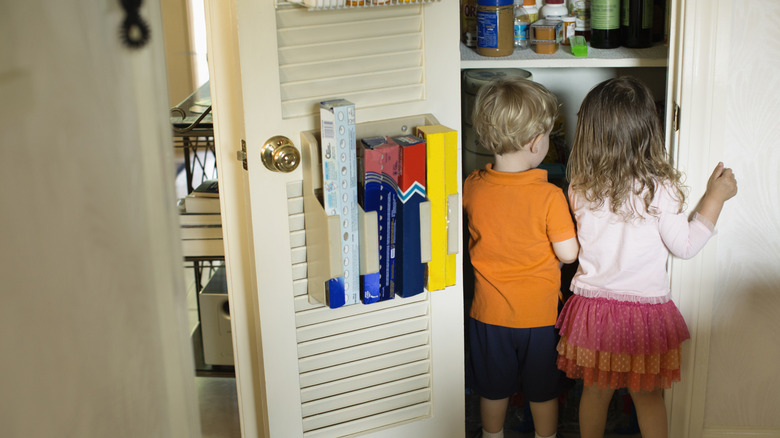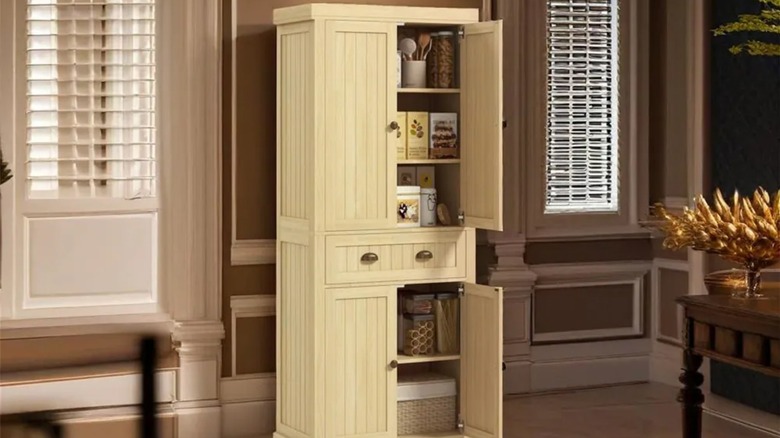How To Create A Pantry System That Works Hard And Actually Stays Organized
We may receive a commission on purchases made from links.
Does keeping your pantry organized feel like a never-ending battle? You take time out of your busy schedule to clear it out and put things back where they belong. Then, within a few days it has returned to a chaotic mess: Items are on the wrong shelf, bags of chips are crammed above boxes, and anything that's not right at the front is hidden from sight. If this sounds familiar, you're not alone. Despite your best efforts, it may simply mean you haven't come up with the right pantry system that will actually work for you.
With all the food items you store in the pantry, it is essential to keep it organized. This not only lets you quickly get your hands on a specific ingredient you need, but it also helps prevent food waste from those items that get stuck in the back, never to be seen again until you empty the shelves and realize that they've long since expired. Finding a system that works for you can also save you money — you'll be able to easily see what you have to make sure that you don't inadvertently buy an ingredient you already possess. If you're ready to find the solution you've been searching for to keep your pantry organized, you've come to the right place. Ahead, we'll share some tips to help you create a system that will not only help organize your pantry, but make sure it stays organized, too.
Use shelf liners to minimize mess and prevent items from getting lost or stuck through a wire shelf
If your pantry has wire shelves, then you know how frustrating they can be. Not only do spilled cereal, flour, and pasta drop slip through, but bag corners, box lids, and more always seem to get stuck in the gaps. Maintaining an organized pantry when you have wire shelves can be challenging because of this. Beyond the fact that spills can make it disorderly, you also can't always get items to sit straight and level. Fortunately, you can eliminate the frustrations of wire shelving with the relatively simple addition of some shelf liners.
Wire shelf liners, such as the Shelf-IT Liners, often feature locking tabs to keep them in place. Compared to many other types of liners that are pretty thin, those designed specifically for wire shelves are on the thicker side. This design allows them to create a smoother and more stable surface above the wire grid. Keep in mind that most shelf liners are sold in a long roll. You'll want to start by measuring how deep your shelves are to make sure you choose a product that will fit them properly. Additionally, to ensure that you don't under- or over-buy, measure the length of each shelf and add those numbers together to verify how many rolls you should purchase.
Create — and stick with — a grouping system
If you want your pantry to stay functional, then it is essential to start with a well-thought-out and organized space. One step that is crucial to accomplishing this goal is coming up with a method to group items so you can keep them together — and know where to find them in the future.
You may also see grouping referred to as creating zones. Both terms focus on the same end goal: choosing a method to sort the various items in your pantry. In many cases, the best way to group the foods will be by type. For example, keep all of your jars of sauces in one area, canned goods in another, and baking necessities together. Compared to storing items based on their size, creating zones will help ensure you're able to maintain a better idea of what you have, what you need, and where you can find it. Conversely, if you group by size, you may forget about that box of crackers you just purchased, because it is camouflaged by the cereal boxes that are placed around it.
One quick note before you start devising your groups: In order to keep things manageable, it is important to create more general categories, such as "snacks." If you get too specific, you're less likely to maintain the system. For example, sorting out all the different boxes of crackers, fruit snacks, and granola bars may be too overwhelming, causing you to abandon the system altogether.
Choose the right type of baskets and bins for the pantry
You probably already know that bins and baskets can be an asset when organizing a pantry. They can help when grouping items, providing a central location to store smaller items (such as snack bags) or even bulkier ones (like onions). However, did you know that not all bins and baskets are created equal? And, if you make the wrong choice, it could actually set your organizational efforts backwards?
So, how do you choose the right baskets and bins for your pantry? First, there is no one-size-fits-all answer for this question. The answer will vary depending on the size and layout of your pantry and how you want to organize it. However, as a general rule, be careful to avoid choosing anything that is overly deep. If the bins you choose are too deep, you're going to have a difficult time finding what you're looking for. You'll likely end up making more of a mess by needing to dig around in search of what you're looking for. This rule is particularly important when you're looking for bins to keep on the shelves to hold smaller items, such as snacks or seasoning packets. For these needs, something like the Best Choice Products Water Hyacinth Pantry Baskets or the Landneoo Clear Plastic Storage Bins might be ideal. If you are looking to add bins or baskets to your pantry floor to hold bulkier items, then you could consider the Aozita Stackable Wire Baskets with Bamboo Tops.
Make smart use of the back of the pantry door
Part of what holds many individuals back from an organized pantry is a lack of space. When you don't have enough room to lay things out properly, then it is only logical they're going to end up jumbled together and shoved in corners. While you can't enlarge the physical dimensions of your pantry without an renovation, you can make smarter use of the available space. Many overlook the potential the back of the pantry door offers, which is to help you clear up space on your shelves to keep other items better organized and more accessible.
There are several smart ways to use an over-the-door shoe organizer to keep your home clutter free. One of those genius solutions involves hanging it over the pantry door. The small compartments are perfect for holding spices, seasoning packets, and individual snacks. If you have double doors, you can even find narrower shoe organizers, such as the Simple Housewares 12-Pocket Over-the-Door Hanging Shoe Organizer. Beyond repurposing a shoe holder, there are also products that are specifically designed to hang on the back of a pantry door that offer larger compartments to hold boxes, cans, and more. The Moforoco 9-Tier Over-the-Door Pantry Organizer and the ClosetMaid Adjustable Organizer Rack are two such options to consider.
Use risers and under-shelf drawers to create more functional space
Utilizing every inch of cabinet storage space — and using it well — is essential if you want to maintain an organized pantry. There is often a lot of space between each shelf. While this can help you fit tall boxes of cereal, it often leads to a lot of wasted (or misused) space when storing shorter items, such as canned goods, boxes, seasonings, or bags of rice. You either end up with items sloppily stacked on top of one another or several inches of room between the top of an item and the next shelf.
It doesn't have to be this way, however. And, no, you don't have to completely redesign your pantry or add additional shelves. Instead, you can use risers, such as the Simple Houseware Expandable Shelf Organizer, and under-shelf drawers, like the JKsmart Sliding Under-Shelf Organizer, to create a more functional space. There are several ways risers can keep your kitchen beautifully organized — including in the pantry. They essentially give you an additional shelf. You can place items beneath and above the riser, effectively doubling the number of things you can fit. Plus, they won't be sloppily stacked together to make it difficult to find or access what you need. Under-shelf drawers and baskets offer similar benefits. They hang down from an upper shelf, providing a convenient spot to keep smaller boxes, a few cans, bagged goods, and more.
Use gravity can feeders to keep cans tidy
When you open the door to practically any pantry, you're likely to see some canned goods. While almost everyone has several cans in their pantry, they're one item that is difficult to keep organized. Sure, you can stack them. However, then it gets difficult to see what's behind the stack or to even get at the bottom can. Ease your can-storage woes by investing in a gravity can feeder, such as the Deco Brothers Stackable Can Rack Organizer.
These organizers offer a multi-level design, providing you with space to accommodate several canned goods. When you pull out one can, the one behind it will roll to the front so it is easily accessible the next time you need something. When loading the organizer, sort your canned goods by type and make a column of each. That way, what you're looking for will always be right at the front and ready to grab. Since most gravity feeders are wide enough to accommodate two to three cans on each tier and offer three levels, you'll be able to create groups of six to nine different goods.
Add a lazy Susan to corral those random products
Even with bins, baskets, shelf risers, can feeders, and under-cabinet drawers, you'll inevitably be left with some random products that don't seem to have an obvious home. You might also find it difficult to choose the best spot to store the extra dressing and sauce bottles in the pantry. Consider adding a lazy Susan or two to corral these items and to make sure you'll be able to find what you need.
There's a reason some people say lazy Susans are a kitchen's best friend. These rotating trays, like the Landneoo Non-Skid Lazy Susan Organizers, make it possible to access any of the items they hold with ease. Even if one of those dressing bottles is at the back of the lazy Susan, you simply need to turn the base, and it will be right up in front. They eliminate the hassle and frustration of trying to dig into a back corner to locate what you need (and, inevitably, knocking down items that are in the front as you reach). You can even find these turntables with taller sides, such as the Guzon Lazy Susan Turntables with Handles and Raised Edges, to help keep items even better contained.
Label, label, and label some more to keep items easily identifiable
When you (or other members of the household) don't know where something belongs in the pantry, it becomes more likely it will get placed in the wrong spot. Even if you have bins, baskets, and other zones that are well-organized, others in the home who don't understand the system might not be willing to look around. Fortunately, there is a simple solution that can help ensure things make it back where they belong. Adding some labels to your storage bins and containers (or even the shelves themselves) can direct household members towards the right storage location. When you create tags with a label maker, such as the Brother P-Touch PTD220 Everyday Label Maker, it will also help you to quickly locate the ingredients you need.
If you're worried about leaving a sticky residue on your containers and bins or want the flexibility to rotate what you store, you could consider using a genius erasable marker hack to keep your pantry organized. Instead of printing a label, write on plastic containers and bins with an EXPO Dry Erase Marker. Then you can simply erase and re-label as needed. If you have any trouble wiping off the marker, a Mr. Clean Magic Eraser can help.
Strategically place frequently-used items towards the front
As you're considering the ideal layout for your pantry, balance and aesthetics are important. However, if you overlook function, you may be setting yourself up for failure. Think about how frequently each item is used and keep that in mind when deciding where it should go. For example, if you bake regularly, putting the flour and sugar containers in a back corner isn't going to be the best idea. Sure, they may fit nicely, but if you have to move things every time you bake just to access them, you're creating unnecessary work for yourself.
Such a system is also more likely to fall apart. Are you really going to stick with moving things around, or will you end up just shoving them somewhere more convenient? Instead, keep those items you use regularly towards the front. Leave the back corners and upper shelves for things you rarely access. This is where pantry organization has to be tailored to suit your specific household and lifestyle.
Keep children accountable (and less likely to disrupt the rest of the flow) with an assigned shelf or bin
If you have young children, you may find yourself facing a dilemma. On one hand, you want to start teaching them how to be organized and maintain the system in the pantry. On the other hand, there are so many components to a well-laid-out pantry that it may be unrealistic to expect them to keep everything straight. Leaving them on their own may result in misplaced items and a quick return to chaos.
Consider assigning one shelf (or even a bin) to your child or children and giving them the responsibility of keeping it organized. You can add snacks they're allowed to access on their own, and set the expectation that they keep those items neat and accessible. You might even want to get a bin with sections, such as one of the Vtopmart 4-Compartment Clear Plastic Bins, that they can use to practice sorting and grouping. This will give them some responsibility, but still help ensure your overall system is preserved.
Consider adding additional pantry space, if possible
If you have a small pantry, it can be difficult to keep it organized, especially if there are several people living in the house. Depending on the size of your kitchen, you may be able to add a pantry cabinet to provide extra storage space. A cabinet, such as the Ironck Kitchen Pantry Storage Cabinet, will provide you with several additional shelves you could use to clear up space in the main pantry and allow each section to remain better organized.
If adding an entirely new cabinet or shelving unit to your kitchen is out of the cards, then you may also be able to add more shelf space inside your existing pantry. For example, these Miyuptc Adjustable Closet Storage Shelves could break up overly tall shelves to provide a good spot to store lighter items. Alternatively, if there is unused wall space, mount some floating shelves, such as the Vdomus Acrylic Clear Floating Shelves, to hold small boxes, sachets, and other items.
Straighten your pantry before grocery trips
Frequently re-straightening your pantry can go a long way towards helping you maintain the organizational system you devise. One of the best times to complete this maintenance task is before heading to the grocery store. This way, you can make sure you don't inadvertently add something to your list that you already have (or skip adding something that you actually need).
Before you start worrying about adding one more thing to your to-do list before shopping, keep in mind that this won't be a deep clean or a huge decluttering project. You'll just be breezing through to make sure that the bins are in the right location, things are in order, and there aren't any surprises waiting for you. Plus, when you arrive home with your arms full of groceries, it will be easier to ensure they get put where they belong and not simply shoved in random places.
Try a pantry organization app to help you track inventory and expiration dates
If you like using the latest technology to help you keep up with everything around the house, then you might want to download a pantry organization app. There are a variety of apps out there, including KitchenPal and MealBoard, that offer features to help you create and maintain an inventory of the items in your pantry. Keeping this inventory updated can make it easy for you to plan your meals and create corresponding grocery lists.
Many of these apps have a database of product information, so when you scan a barcode, the item will automatically show up. Some will even let you enter expiration dates and will send you alerts to make sure you don't let food go to waste before it expires.
